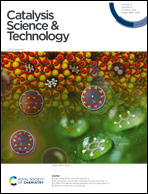Ruthenium-catalysed hydroxycarbonylation of olefins†
Abstract
State-of-the-art catalyst systems for hydroxy- and alkoxycarbonylations of olefins make use of palladium complexes. In this work, we report a complementary ruthenium-catalysed hydroxycarbonylation of olefins applying an inexpensive Ru-precursor (Ru3(CO)12) and PCy3 as a ligand. Crucial for the success of this transformation is the use of hexafluoroisopropanol (HFIP) as the solvent in the presence of an acid co-catalyst (PTSA). Overall, moderate to good yields are obtained using aliphatic olefins including the industrially relevant substrate di-isobutene. This atom-efficient catalytic transformation provides straightforward access to various carboxylic acids from unfunctionalized olefins.



 Please wait while we load your content...
Please wait while we load your content...